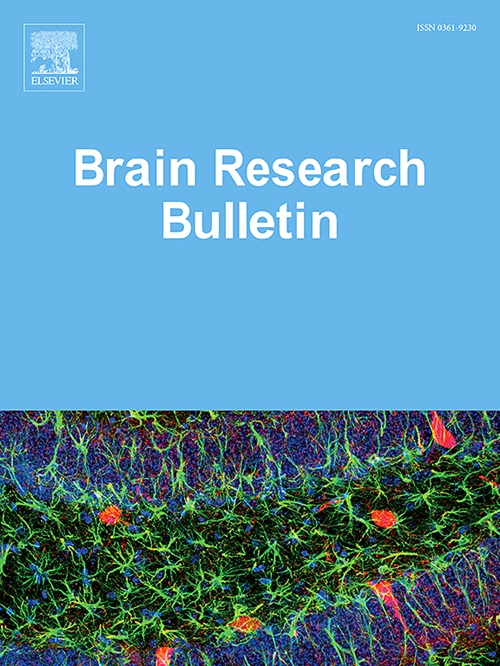揭开围产期抑郁症的面纱:用于诊断和严重程度评估的双网络脑电图分析。
IF 3.5
3区 医学
Q2 NEUROSCIENCES
引用次数: 0
摘要
围产期抑郁症(PD)约影响 10%至 20%的妇女,由于相关症状经常与孕期常见症状重叠,因此常常不被人们注意。此外,目前识别围产期抑郁症在很大程度上依赖于问卷调查,而用于诊断的客观生物指标尚未确定。本研究提出了一种安全、无创的方法来诊断妊娠迟缓症,并旨在深入研究其潜在机制。考虑到脑电图(EEG)对准妈妈和胎儿的无创性和临床便利性,我们收集了妊娠第 38 周孕妇(患有帕金森病/健康)的静息态头皮脑电图。为了弥补头皮脑电图空间分辨率低的缺陷,我们首先应用源分析将头皮脑电图投射到皮层空间。然后,构建皮层空间网络和大尺度网络,从两个不同层面研究帕金森病的发病机制。在此,我们分别探讨了帕金森病患者和健康准妈妈两种不同类型网络的差异。我们发现,帕金森氏症患者在皮层空间的网络连通性下降,而大尺度网络则显示小脑区域的连通性减弱。此外,从这两种不同网络中得出的相关空间拓扑特征被结合起来,以促进对患有帕金森氏症的孕妇和健康孕妇的识别。同时,根据组合的空间拓扑特征,还能有效预测患者的抑郁严重程度。这些研究结果一致验证了两种网络确实可以相互影响,从而有助于探索帕金森氏症的内在机制,并进一步验证了组合策略的优越性,揭示了其在诊断和抑郁严重程度评估方面的可靠性和潜力。本文章由计算机程序翻译,如有差异,请以英文原文为准。
Unveiling perinatal depression: A dual-network EEG analysis for diagnosis and severity assessment
Perinatal depression (PD), which affects about 10–20 percent of women, often goes unnoticed because related symptoms frequently overlap with those commonly experienced during pregnancy. Moreover, identifying PD currently depends heavily on the use of questionnaires, and objective biological indicators for diagnosis has yet to be identified. This research proposes a safe and non-invasive method for diagnosing PD and aims to delve deeper into its underlying mechanism. Considering the non-invasiveness and clinical convenience of electroencephalogram (EEG) for mothers-to-be and fetuses, we collected the resting-state scalp EEG of pregnant women (with PD/healthy) at the 38th week of gestation. To compensate for the low spatial resolution of scalp EEG, source analysis was first applied to project the scalp EEG to the cortical-space. Afterwards, cortical-space networks and large-scale networks were constructed to investigate the mechanism of PD from two different level. Herein, differences in the two distinct types of networks between PD patients and healthy mothers-to-be were explored, respectively. We found that the PD patients illustrated decreased network connectivity in the cortical-space, while the large-scale networks revealed weaker connections at cerebellar area. Further, related spatial topological features derived from the two different networks were combined to promote the recognition of pregnant women with PD from those healthy ones. Meanwhile, the depression severity at patient level was effectively predicted based on the combined spatial topological features as well. These findings consistently validated that the two kinds of networks indeed played off each other, which thus helped explore the underlying mechanism of PD; and further verified the superiority of the combination strategy, revealing its reliability and potential in diagnosis and depression severity evaluation.
求助全文
通过发布文献求助,成功后即可免费获取论文全文。
去求助
来源期刊

Brain Research Bulletin
医学-神经科学
CiteScore
6.90
自引率
2.60%
发文量
253
审稿时长
67 days
期刊介绍:
The Brain Research Bulletin (BRB) aims to publish novel work that advances our knowledge of molecular and cellular mechanisms that underlie neural network properties associated with behavior, cognition and other brain functions during neurodevelopment and in the adult. Although clinical research is out of the Journal''s scope, the BRB also aims to publish translation research that provides insight into biological mechanisms and processes associated with neurodegeneration mechanisms, neurological diseases and neuropsychiatric disorders. The Journal is especially interested in research using novel methodologies, such as optogenetics, multielectrode array recordings and life imaging in wild-type and genetically-modified animal models, with the goal to advance our understanding of how neurons, glia and networks function in vivo.
 求助内容:
求助内容: 应助结果提醒方式:
应助结果提醒方式:


